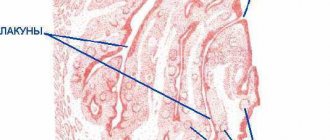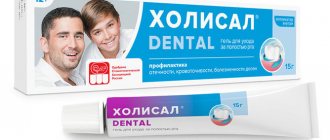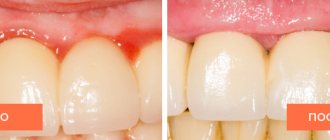Chronic tonsillitis is a chronic inflammation of the tonsils.
The palatine tonsils (popularly called tonsils) are an important part of the human immune system.
Bacteria, viruses, and microscopic fungi enter us with food and air. They settle on the mucous membranes, where they are picked up by a constant current of mucus, and this “river” flows in the direction of the oropharynx, just where the tonsils are located behind the palatine arches.
The palatine tonsils are like a sponge. They are dotted with gaps. When we swallow a bolus of food soaked in infected mucus, this mucus enters the lacunae of the tonsils. There, foreign microorganisms are attacked by the guard cells of the primary immune response: neutrophils and macrophages. The latter not only kill the infection, but also “cut” it into small molecular fragments, on which young cells of the secondary immune response—lymphocytes—are then “trained.” Prepared and trained lymphocytes emerge from the tonsils and “spread” throughout the mucous membranes of the pharynx and nose, forming a fairly reliable secondary specific defense.
Causes
Purulent tonsillitis is a lesion of the parenchyma of the tonsils, the follicular complex of the nasopharynx. The disease is characterized by an acute onset, fever, sore throat, enlarged lymph nodes, and the presence of purulent plaque on the tonsils.
The causative agent of sore throat gets on the surface of the tonsil. As a result of the combined effect of reduced local (local) and general immunity, favorable conditions are created for the manifestation of its pathogenic activity.
The main route of infection is airborne, but transmission of pathogenic microorganisms through contact and household contact cannot be ruled out (for example, through utensils used by a sick child or adult). The incidence increases from spring to autumn.
The most common cause of the disease is hemolytic streptococcus, but some other microorganisms, viruses and fungi can also be causative agents. Purulent tonsillitis is provoked by a number of factors.
These include:
- weakening of the body's protective properties;
- the presence of foci of infection in the oral cavity (stomatitis, caries, cheilitis, etc.);
- long stay in a smoky room;
- inhalation of polluted air;
- hypothermia;
- alcohol abuse;
- tonsil injuries.
Sources of infection can be sick people (airborne infection), as well as infected food, dishes and toilet items (in this case, sore throat is transmitted by contact).
Causes of pathology
Lacunar tonsillitis causes damage to the palatine, pharyngeal, lingual, and tubal tonsils, but more often pus-filled lacunae are found in the palatine tonsils (tonsils). Up to 90% of cases of the disease are caused by beta-hemolytic streptococci (group A), less often by other bacteria:
- staphylococci;
- pneumococci;
- Haemophilus influenzae;
- Klebsiella
In addition, sore throat can initially be caused by viruses (enteroviruses, adenoviruses), which weaken the body's resistance, as a result of which bacteria begin to actively settle on the mucous membrane of the tonsils.
In childhood, 70% of cases of the disease are detected after initial contact with certain strains of streptococcus and staphylococcus. In the future, lacunar tonsillitis can develop after any decrease in local immunity - with hypothermia, consumption of cold food, drinks, a decrease in the general resistance of the body, after a severe infectious disease. This occurs due to the fact that bacteria remain in foci of chronic infection in the body - in the nasopharynx, sinuses, teeth, gums, from where they can invade the tonsils.
OUR READERS RECOMMEND!The most effective remedy for losing excess weight, according to our readers, is Dietonus. Dietonus is a revolution in weight loss and a double blow to excess weight. Doctors' opinion.
Would you like to know how lacunar tonsillitis occurs in children? Then you should read this article.
In addition, sore throat during late pregnancy can become a serious complication for the health of the mother and the unborn baby.
In general, the state of the immune system is a determining factor for the development of lacunar tonsillitis: in the presence of strong immunity, pathology occurs much less frequently, and its treatment is faster and easier. People with certain systemic diseases are more susceptible to sore throat. Among the risk factors for the occurrence of the disease:
- allergic conditions;
- diabetes;
- blood diseases;
- rheumatism;
- tuberculosis;
- stress;
- unfavorable environment;
- smoking;
- chronic sinusitis;
- periodontal disease;
- caries.
Occasionally, the causes of lacunar tonsillitis are associated with trauma to the tonsils and direct infection in their tissue, for example, when a bone gets in, damage from a tooth fragment, after FGS.
Treatment with folk remedies
Folk remedies help relieve sore throat. They don't require many ingredients to make them.
Teas and decoctions
- Boil seven to eight figs in a glass of milk for seven minutes. Cool the broth and drink warm three to four times a day before going to bed.
- Dissolve one tablespoon of butter in a glass of warm milk, add one tablespoon of honey. Drink the drink warm four to six times a day.
- Pour one tablespoon of dried linden flowers into a glass of boiling water and brew. Cool and strain the broth, then drink fifty milliliters three or four times a day.
- Teas with raspberries or rose hips are good for relieving sore throats. They can be drunk in any quantity, but warm.
- Mix one part of anise fruit with the same amount of mullein flowers and coltsfoot leaves, add two parts of thyme flowers, the same amount of mallow flowers, marshmallow root and five parts of licorice root. Take a tablespoon of the resulting mixture, pour a glass of cold water and leave for two hours. After this, bring the infusion to a boil and simmer for another five minutes. Strain and drink a quarter glass four times a day.
- Brew three to four tablespoons of elderberry in a glass of boiling water, simmer for five minutes over low heat. Strain the broth, cool, and use to gargle.
Washing
purulent forms of sore throat
The drugs used as medications are Rivanol, Furacilin, Streptocide, boric acid, and antibiotic solution. You will also need a syringe for rinsing. It needs to be filled with medicine, herbal decoction, saline or saline solution.
If salt is used, it is better that it be sea salt. The solution is prepared at the rate of one teaspoon per glass of water.
Rinse
Treatment of sore throat is very effective if you supplement teas, decoctions and gargling. Let's look at a few folk recipes:
- Pour two teaspoons of onion peel into two glasses of water. Cook for three minutes. Leave the broth for three to four hours, then strain and gargle three to four times a day.
- Add one teaspoon of salt, three drops of iodine and half a teaspoon of soda to a glass of warm water.
- Brew one teaspoon of chamomile flowers in one glass of water, strain, cool and gargle.
- Add one teaspoon of lemon juice to one glass of water. Gargle three to four times a day.
Compresses on the throat
Compresses on the throat can be considered one of the most effective and safest ways to treat sore throat. This procedure can be carried out for quite a long time.
To carry out the procedure, it is necessary to prepare soft tissue that absorbs liquid well. It needs to be dipped in the compress solution, squeezed out and applied to the throat.
For compresses, you can use beekeeping products, for example, honey, beeswax, propolis. Such compresses activate blood circulation in the capillaries, remove toxins and normalize metabolism in cells. The cabbage leaf is poured with boiling water to soften it. When it cools down, take it out and wipe it, and then spread it with honey. This compress is applied to a sore throat. The top is also insulated with polyethylene and a scarf.
Another option for compresses is compresses with homemade cottage cheese. Take two hundred and fifty grams of cottage cheese and rub it through a sieve. Add a couple of grated onions or two tablespoons of honey. This compress is applied to the throat and insulated.
Essential oils
Essential oils contain substances that, when evaporated, enter the respiratory tract and are deposited on the walls. The result is a therapeutic effect.
- Cypress essential oil. It is an antiseptic. Used for inhalation and massage. For massage, apply a few drops of oil to the chest and neck and rub into the skin. After the procedure, wrap yourself up and lie down for half an hour.
- Essential oil of menthol. It contains substances that fight many pathogenic microorganisms and clear the nasopharynx of secretions. Used for rubbing the bridge of the nose and dry and wet inhalations.
- Orange essential oil. It is used for the treatment of viral infections of the nasopharynx and throat in the form of inhalation, massage, and rubbing. It is recommended to use dry inhalations on fabric and porcelain and wet ones.
- Tangerine essential oil. Used as an adjuvant for the treatment of sore throat. Suitable for inhalations, massages, compresses, foot baths.
- Eucalyptus essential oil. Used for inhalations, baths, massage, rubbing.
Treatment for exacerbations
Gargling and rinsing the throat
If you don’t have the necessary ingredients, you can simply gargle with warm boiled water. It irrigates the throat and flushes out pus and dead tissue. To rinse, put the solution in your mouth, throw your head back and make some sounds, and spit out the solution. You must use at least 150 ml of liquid. It should be warm and comfortable. The procedure is recommended to be carried out an hour before meals. Solutions with the addition of the necessary ingredients not only wash away pus, but also reduce pain, swelling in the throat and even promote rapid regeneration of palatal tissues.
Solution with soda, salt, iodine
Boil and cool water (200 ml) to room temperature. Add a teaspoon of salt and soda to it, drop a couple of drops of iodine. Gargle with the prepared solution at least 5 times a day.
Hydrogen peroxide solution (3%)
Pour one and a half to two tablespoons of peroxide into a glass of warm boiled water. Stir and start gargling.
Yukalo T. N. offers good and quite effective recipes in the “Big Directory of Traditional Medicine” p. 18 (Donetsk: publishing house, 2008)
Infusion of medicinal herbs
Pour 200 ml of boiling water over a teaspoon of thyme, chamomile and calendula flowers. Wrap up for thirty minutes. Strain, add honey.
Rhodiola rosea (golden root) tincture
One of the most effective remedies for treating tonsillitis at home is radiola rosea root.
Pour two tablespoons of root into a half-liter bottle of vodka. Let it steep for at least 7 days. A teaspoon of this tincture should be diluted in 100 grams of warm water and rinsed for 10 minutes. If you carry out the procedure regularly, the disease can go away within a day.
Beet juice
Choose red beets, grate on a fine grater to one glass of the mixture and add one and a half tablespoons of 9% vinegar or two, but 6 percent. Squeeze thoroughly and strain. You can not only gargle a sore throat with this solution, but it is also advisable to drink a couple of tablespoons.
Teas and decoctions
Various teas and decoctions are very good at treating inflammation and strengthening the immune system during illness:
- Raspberries. Measure out one and a half tablespoons of dried raspberries and add 200 ml of water. Bring to a boil and cool to room temperature. In total, you need to prepare three such servings per day.
- Linden. Prepare a decoction of two tablespoons of dried linden flowers and 200 ml of water. Insist. Drink at night.
- Blackberry. Pour boiling water over two tablespoons of blackberries and let it brew. Apply three times a day.
- Ginger, raspberries, honey, vegetable oil. Mix three ingredients one tablespoon at a time, only 1 teaspoon vegetable oil. Pour three glasses of boiling water over everything and wrap it up. You need to insist all night. Strain and drink a glass an hour before meals.
Effective Home Remedies
- If you feel a sore throat coming on, cut the lemon into thin slices and suck on them. The interval of this procedure is an hour.
- Propolis will help at any stage of tonsillitis. To do this, you need to take a very small piece of propolis (1.5 grams) and chew it after eating. You can eat up to 5 grams of this bee product per day. Only propolis must be of high quality. Then, when chewing, a slight numbness of the tongue is felt.
- Calamus root is a good disinfectant for the oral cavity. Peel a piece of root and simply chew it constantly after eating.
Compresses on the throat
Warm, dilate small peripheral vessels.
- Compress with potatoes. Three medium-sized potato tubers with skin should be boiled. While hot, mash them a little with a fork. Place on a clean rag or gauze and wrap it around several times. The potatoes should be warm. Place it on your throat and cover it with a scarf.
- Vodka compress. Warm the vodka slightly to room temperature. Fold a piece of soft cloth into quarters and soak it in alcohol. Squeeze. Gently place on your throat. You need to place polyethylene on top, but so that it covers the gauze completely. The third layer in this compress is a warm scarf.
Essential oils for the treatment of tonsillitis
They are quite powerful antiseptics.
You can lubricate inflamed areas with essential oils, add a few drops (2-3) to tea, perform inhalations, and gargle. For this simple procedure, drop up to 5 drops into a glass of warm boiled water and rinse up to ten times a day. But it is best to use essential oils in aroma lamps. For angina use:
- Fir oil;
- Sea buckthorn oil;
- Pine oil;
- Cedar oil;
- Eucalyptus oil;
- Tea tree oil.
Using traditional methods
It is possible to cure purulent sore throat with folk remedies when it is not yet very advanced. This therapy also works well as an adjunct to drug treatment.
Compress recipes
Alcohol compress.
- Dilute medical alcohol (70%) in warm water in a 1:1 ratio.
- Add a few drops of orange and lavender essential oil.
- Soak the gauze in the prepared solution and use it as a compress to the throat (apply for 1–2 hours). People with sensitive skin need to hold the compress for no longer than 30 minutes.
Potato compress
- Boil a few potatoes with their skins.
- Mash the finished potatoes and add five drops of iodine and a tablespoon of vegetable oil.
- Place the finished mixture in a gauze bag.
- Apply the compress to your throat for 40 minutes.
Raw potato compress
- Grate four medium potatoes on a fine grater.
- Pour in a tablespoon of apple cider vinegar.
- Mix everything well and place in a gauze bag.
- Apply to the throat for 2 hours.
Cabbage compress
- Pour boiling water over a few raw cabbage leaves.
- Leave for a few minutes until the leaves soften.
- Remove the leaves from the water and wipe it dry.
- Lubricate with honey and apply to a sore throat.
- Wrap film on top.
- Leave for 2 hours, then remove the compress and wrap your throat with a warm wool towel.
Recipes for inhalations
- Boil a few potatoes. Cut and place in a deep bowl. Breathe hot steam from the potatoes, covering your head with a towel.
- Mix a spoonful of honey with five drops of orange essential oil. Inhale the aroma for at least 10 minutes.
- Brew cool black tea. Add a tablespoon of mint to it. Use for inhalation.
- Take sage, mint, thyme, pine buds and elecampane roots in equal proportions. Brew these herbs in a liter of water. Breathe the steam from the decoction.
Garlic remedies
- Peel two heads of garlic and chop the cloves. Add two tablespoons of apple cider vinegar to them. Leave for 12 hours. Then add a spoonful of honey to the product. Take half a teaspoon of this mixture daily.
- Squeeze juice from carrots. Add two chopped garlic cloves to it. Drink this remedy before meals, 2 times a day, a tablespoon.
- Squeeze the juice from peeled garlic. Drink a few drops of juice a day. The product will help cure purulent sore throat very quickly.
Rinse recipes
- Take two tablespoons of dry chamomile and one spoon of linden flowers. Pour boiling water (1 liter). Strain and gargle 5 times a day.
- Infuse five tablespoons of horsetail in 500 ml of boiling water for an hour. Then strain and gargle with it at least 3 times a day.
- Pour two tablespoons of raspberry leaves with a glass of boiling water. Leave for 20 minutes for the product to infuse and cool. Use for rinsing.
- Grate the red beets and squeeze the juice out of them. Add a teaspoon of vinegar to one glass of juice. Mix everything and use as a gargle twice a day.
- Pour four fresh plantain leaves into a glass of boiling water and leave for half an hour.
- Mix half a glass of lemon juice with 200 ml of warm water. Use for rinsing.
- Mix dry chamomile and calendula in a ratio of 1:3. Boil in a liter of water. Leave for 2 hours. Cool and gargle with the prepared product.
- Take calendula and chamomile flowers, wormwood and plantain in equal proportions. Boil the herbs in a liter of water. After this, let it brew for 2 hours. Strain and use for rinsing.
- Take a teaspoon of dry sage and a tablespoon of chamomile. Pour the mixture with 500 ml of boiling water and leave it for 24 hours. Strain. Gargle at least 3 times a day.
It is also important to take enough fluid (at least 2 liters of water or compote per day). In addition, the patient must follow a diet. In order for the body to have enough strength to fight infection, it must receive the required amount of vitamins, minerals and trace elements every day
It is best to eat cereals, vegetable purees, broths and fermented milk products during this period. This food will not cause severe pain when swallowing and will be able to saturate the body well.
How to get rid of tonsillitis symptoms
Treatment of purulent sore throat in an adult begins with taking antibacterial drugs. They are selected depending on the type of infectious agent. The most commonly used antibiotics are penicillin, cephalosporins and macrolides. Replacement of the drug is indicated if treatment is ineffective.
Compresses help improve blood circulation in the neck, but they should not be done at high temperatures. The products are applied so that they do not affect the thyroid gland. The procedure must be carried out before bedtime. Soak a cotton cloth or bandage with a solution prepared in advance. They are applied to the neck area and covered with plastic film. Alcohol compresses are simple and effective. 70% alcohol is mixed with water in equal proportions.
Gargling is considered the most effective method of relieving the symptoms of tonsillitis. It helps cleanse the tonsils of plaque, relieve inflammation, and speed up recovery. There are many ways to prepare the solution. 1 tsp. dilute soda in a glass of water, gargle at least 4 times a day. A solution of table salt is prepared in the same way. Before the procedure, add a few drops of iodine to it.
Treatment of purulent sore throat at home can be carried out using hydrogen peroxide. It destroys the infectious agent and improves the condition of lymphoid tissues. This remedy is used to treat tonsillitis, pharyngitis, and laryngitis. 1 tsp. A 3% solution is mixed with a glass of warm boiled water. When rinsing, purulent plaque is washed away, which prevents the spread of infection in the body and helps the signs of intoxication disappear. The solution is also used to treat tonsils. The basic rule for its application is the need to dilute it with water in a 1:1 ratio. Oxidation has a detrimental effect on bacteria, fungi and viruses. Peroxide dissolves hard caseous plugs, facilitating their removal.
The effectiveness of inhalations is due to several reasons. The vapors have a beneficial effect on the mucous membranes, eliminate pain and swelling. The films are separated from the surface of the tonsils and are quickly removed when rinsing. For inhalation, drugs such as Chlorophyllipt and Chlorhexidine can be used. Good results are observed when using decoctions of chamomile, sage or yarrow. The prepared infusion is filled into an inhaler or nebulizer. In the absence of these devices, the broth is heated in a saucepan, over which you need to breathe, covered with a towel. The course of inhalations must last at least 7 days. Procedures are carried out 1-2 times a day. This treatment is contraindicated for arterial hypertension, high fever and cancer.
To treat the mucous membranes of the throat, you can use Lugol's solution, which is available without a prescription. It contains iodine, which has a detrimental effect on pathogenic microorganisms. Glycerol softens mucous membranes, eliminates pain and sore throat. The convenient sprayer allows you to simultaneously treat the tonsils, larynx and oral cavity. Apply it 3-5 times a day; after spraying, you must refrain from eating and drinking. The solution can be kept in the mouth or applied to a cotton swab, which is used to treat the mucous membranes of the throat and enlarged tonsils.
The popularity of this drug is explained by its effectiveness against most infectious agents. In addition, iodine prevents the development of thyroid pathologies. The disadvantage of Lugol's solution is its specific taste, which contributes to the gag reflex. This drug has contraindications, which your doctor should tell you about. Side effects include: increased sweating, skin rashes, drooling, tachycardia and insomnia.
Treatment of sore throat in adults
Only an ENT specialist can tell you how to treat a sore throat quickly and effectively using medications at home. It is he who will prescribe effective antibiotics and other medications that are necessary to cure a sore throat and eliminate the symptoms of this disease.
Even before the doctor arrives at home, the patient should, if possible, be placed on bed rest, and should be placed in a separate room. A person with tonsillitis is given separate dishes, a towel and other individual household items. The room in which the patient lies is ventilated several times a day, the floor should be washed with chloramine at least once a day.
The following recommendations will help reduce pain and speed up the healing process at home:
Drink more warm liquids. The measure will prevent dehydration and make swallowing easier. Protect your voice. It is recommended to talk (especially in a raised voice) as little as possible. It is best to maintain complete silence until recovery. Take lozenges against a sore throat. Drink tea with honey and lemon. The drink will strengthen the immune system, help destroy germs and relieve pain.
It is important that the temperature is comfortable for reception. Gargle with a solution of salt or soda whenever possible. Systematically humidify the air in the room. A measure to reduce irritation of mucous membranes.
It is not advisable to carry any type of sore throat on your feet. And with staphylococcal or streptococcal forms, bed rest is required for the first 5–6 days (and in severe cases, more than 10 days). Most often, it is not possible to quickly cure a sore throat in an adult. For purulent forms of the disease, antibiotics are prescribed.
How to treat purulent sore throat?
Purulent sore throat treatment at home in adults is accompanied by high fever and distortion of taste buds.
Potatoes and vinegar.
Grate two medium potatoes on a fine grater and mix with 2 tablespoons of vinegar. Apply to the throat as a compress;
Treatment of sore throat with kerosene.
Take 2 drops of distilled (purified) kerosene after meals twice a day for no more than 5 days;
Ginger and lemon.
Mix grated ginger - 3 tbsp. spoons and a whole lemon in a meat grinder. Mix with 3 tablespoons of honey. Take 1 teaspoon 5 times a day.
Home treatment for purulent sore throat in children
Treatment of purulent sore throat at home in children is a complex of measures: compresses, inhalations and ointments. Often a decision is made on a local antibacterial drug:
- Biseptol,
- Lorangin,
- Tantum Verde.
Treatment with folk remedies is aimed at eliminating sore throat:
- Rinsing with a decoction of chamomile and sage;
- 1 tablespoon of hydrogen peroxide per 200 grams of water. Rinse in random order;
- A decoction of red onion peel. Gargle at least 5 times a day;
- Cabbage juice – 100 grams, propolis – 10 grams, dissolve, mix and take 1 tablespoon three times a day.
Medications
Because sore throat can cause complications. Then the doctor decides to prescribe medication:
- Antibiotics: Flemoxin, Azithromycin, Ericicline;
- Antiviral: Tamiflu, Relenza;
- Antihistamines: Fenistil, Loratadine, Suprastin;
- Vitamins: B12, B6, C, A, E;
- Local spray: Aqualor, Tantum-Verde, Orasept, Angal S, Anginal, Lorangin, Yox;
- Antimicrobial drugs: Loprax, Grammidin.
Sore throat is a problematic and complex disease. You can carry out treatment at home using traditional methods. But, if there is a risk of complications, it is best to seek help from specialists who, if necessary, will hospitalize you and carry out therapeutic actions in a hospital setting.
The issue of hospitalization of children under 3 years of age is particularly acute. Babies often lose a lot of fluid, and the whole body becomes dehydrated.
Medications
Drug treatment of purulent tonsillitis includes the use of the following drug groups:
- Antibiotics. Doctors prescribe these drugs in 70% of cases to avoid complications. With their help, you can quickly destroy all pathogenic microorganisms and prevent the worsening of symptoms.
- Corticosteroids. These drugs help eliminate swelling, which increases pressure on the respiratory system.
- Antipyretic. Prescribed at elevated body temperatures, which makes it impossible to use compresses and other warming methods of treatment.
- Lozenges. Used to relieve sore throat. They are prescribed when a person has pain when swallowing or constant, aching pain.
- Antiseptic sprays. Most often prescribed are Faringosept, Stopangin, Orasept, and others. You can buy Kurunga Spray at Argo. It reduces swelling and hyperemia of the oral mucosa, neutralizes viruses, fungi, bacteria on the surface of the oral mucosa, tonsils, and throat.
Drugs for purulent tonsillitis during pregnancy are prescribed with extreme caution. Treatment is carried out under constant medical supervision, with emphasis on the use of folk remedies.
Thus, it is better to coordinate the treatment of purulent tonsillitis with your doctor, especially if independent therapy for 3-4 days has not brought results.
For many, the use of folk remedies such as milk and honey, onions, garlic, propolis, and peroxide has proven effective. These recipes can also be supplemented with drug therapy.
Possible complications of a purulent process in the throat
Treating purulent tonsillitis at home is allowed only after detailed consultation with specialists, since self-medication is considered dangerous for any form of tonsillitis, and especially for complicated purulent tonsillitis. The pathological process can provoke serious complications in the patient, leading to severe chronic disorders in the body and, in some cases, to fatal consequences.
- The migration of purulent formations into the deep layers of the muscle tissue of the throat and pharynx provokes the occurrence and progression of tissue abscess.
- Untimely and poor-quality treatment of purulent tonsillitis can provoke the penetration of purulent infection into the meninges. Against the background of rupture of a purulent focus, the patient may experience progression of a purulent form of meningitis.
- Self-opening of purulent foci provokes the penetration of pus into the auditory tube, against this background purulent inflammation of the eardrum, ears and inner ear develops.
- The spread of pyogenic microbes throughout the body provokes a general blood infection in the patient with a possible fatal outcome.
- The purulent form of tonsillitis often provokes the development of secondary pathology of internal organs: heart, kidneys, joints.
These complex pathological processes in the body are provoked by streptococcal bacteria against the background of a late response in the treatment of tonsillitis.
Possible complications
With lacunar angina, complications often develop. The most dangerous of them are:
- tissue phlegmon;
- abscess formation;
- swelling of the larynx;
- difficulty breathing;
- oxygen deficiency;
- purulent inflammation of the ear;
- inflammation of the lymph nodes;
- development of chronic tonsillitis.
Negative consequences from internal organs are possible. The spread of microbes often leads to kidney damage such as glomerulonephritis, myocarditis and rheumatism.
The most serious complication of tonsillitis is sepsis. It can lead to shock and multiple organ failure (a combination of failure of several functional systems).
How to quickly cure a sore throat in children?
Treatment of sore throat in children at home is associated with the risk of complications. Along with the fact that children can easily tolerate high temperatures, children cannot tolerate sore throats.
Therefore, all recipes are initially aimed at eliminating severe swelling and inflammation of the larynx:
Cranberry infusion. Squeeze fresh berries and chop dry ones. Pour 250 grams of boiling water over 50 grams of berries, let cool and take 50 grams 5 times a day;
A mixture of honey and garlic. Squeeze garlic juice (1 head) into honey (250 grams). Allow the child to suck before meals 20 minutes 3-4 times a day;
Tea made from raspberry, currant and apple branches. Brew and give instead of drinking water in an arbitrary proportion;
Aloe and linden. Grind the aloe pulp to obtain a paste in the amount of 3 tablespoons. Prepare a steep decoction of linden flowers (2 tablespoons of flowers per 250 grams of boiling water). Then mix aloe juice and strained linden decoction, dilute with 300 grams of boiled, cooled water and give the baby 50 grams to drink 3 times a day.
Important: This recipe is strictly prohibited for children with kidney disorders and diseases!
Milk with honey
Milk with honey is a common recipe, known even to children. The drink has many beneficial properties and is also pleasant to the taste. It seems to “lubricate” the throat, enveloping it, which helps soften the mucous membrane and eliminate painful sensations. Also, milk with honey strengthens the body, immunity, and energizes. However, in order for all the beneficial properties to appear, it is important to prepare the drink correctly.
There is no need to boil the milk, just heat it to a warm temperature. It is better to use liquid honey - fresh, but if it has hardened, it must first be melted in a water bath. After mixing the components, the drink cools to room temperature (40 degrees), then it should be drunk in small sips.
Adults are recommended to drink 2-3 glasses a day, children – 100 ml 2-3 times a day.
There are other cooking options:
- for 200 ml of milk add 20 g of honey and butter;
- adding a small amount of cinnamon;
- For 200 ml of milk add 20 g of honey and freshly squeezed carrot juice and others.
Advice! These products, especially honey, are strong allergens. If you have an allergic reaction, it is prohibited to use milk with honey.
Treatment of sore throat in children at home with folk remedies
Beet juice
Grate the beets on the finest grater, squeeze out the pulp well, add vinegar with a concentration of 6% to the resulting juice, in a ratio of 1 part vinegar to 10 parts juice, gargle with the solution every hour. A good anti-inflammatory effect will be provided, and the swelling of the tonsils will also decrease.
Chamomile
Add 1 teaspoon of pharmaceutical, dry chamomile to 300 milliliters of boiling water and leave for an hour. Store the finished infusion in the refrigerator, rinse the neck with the heated solution up to three times.
Sea buckthorn
Add a tablespoon of sea buckthorn oil to half a glass of boiled, cooled water or chamomile infusion; the rinsing process creates an enveloping and analgesic effect.
Milk with garlic
Mix 300 milliliters of milk with a large head of finely chopped garlic and put on fire until it boils. Strain, give 15-30 ml, several times a day. Improvements are observed after the first day of use.
Aloe honey
Cut 2 large aloe leaves into large pieces, place in a jar and pour half a liter of honey, close tightly with a lid and put in the refrigerator to infuse for three days. 10-15 minutes before each meal, give the child a teaspoon of treats. Course 3-7 days.
Medicines
Panadol, Viferon, Tantum Verde, Anaferon, Angin Hel, Bioparox, Faringosept. (Consult your doctor first)
How does angina occur and how is it treated?
Sore throat is an inflammation of the lingual and nasopharyngeal tonsils, as well as the palate. Sore throat is caused by infection. As a rule, the causative agent of the disease is group A streptococcus.
A sore throat can develop as a result of hypothermia, chronic tonsillitis, decreased immunity, or allergization of the body. However, the main cause of the disease is an infection that is transmitted by airborne droplets.
The main symptoms of the disease include headache, high body temperature, severe sore throat, and redness of the mucous membranes of the throat. In some cases, a white coating forms on the tonsils and aches in the joints occur.
Sore throat can be acute or chronic. The acute form of the disease occurs as a result of a pathogenic microorganism entering the body. Treatment of the acute form without antibiotics is impossible. In addition, in this case, the disease always occurs with high fever, severe sore throat and other characteristic symptoms.
In the absence of proper treatment for the acute form of the disease, it becomes chronic. This stage is poorly treated with penicillin antibiotics. As a rule, in this case, drugs from the microlide group are prescribed.
Regardless of the form of the disease, homemade recipes for sore throat are effective and completely safe for health.
Use of antibiotics
Seeing a doctor in case of acute tonsillitis is necessary for diagnosis and development of a treatment plan. In the case of self-treatment, you can skip bacterial tonsillitis, which is most often caused by opportunistic microorganisms, which can only be combated with rational antibacterial therapy. To determine the type of tonsillitis pathogen, a smear is taken from the mucous membrane of the patient’s pharynx or tonsils with culture for flora and sensitivity to antibiotics.
It is not so easy for a patient to distinguish a bacterial sore throat from a viral one by external manifestations. Most often, with viral forms, tonsillitis occurs as part of a general inflammatory process and has other symptoms - runny nose, cough, etc. Typically, most cases of bacterial tonsillitis are caused by streptococci. Streptococcal infection manifests itself in the human body with a body temperature above 38 degrees, enlarged and painful lymph nodes, and hyperemia of the pharyngeal tonsils. If these signs are present, most likely the patient suffers from bacterial tonsillitis, and he needs antibiotics for treatment.
In the treatment of bacterial sore throat, antibacterial drugs from the group of semi-synthetic penicillins, for example, Amoxiclav or Amoxicillin, are effective, but if the patient cannot tolerate them (he has a severe allergy or often develops severe dysbacteriosis when using such drugs), then macrolide antibiotics are used - Sumamed, Clarithromycin, or cephalosporins - ciprofloxacin, levofloxacin. However, the choice of an antibacterial drug should be made only by a specialist, with the selection of the appropriate dosage, frequency of administration and form of the drug.
For bacterial sore throat, therapy with antibacterial drugs usually lasts 10 days. Improvement usually occurs already on the 3rd day of taking antibiotics, but it is absolutely impossible to stop taking them - the point of antibiotic therapy is to completely destroy a specific pathogen in the human body, and if therapy is interrupted, the pathogen's resistance to this drug will appear and a sore throat may develop with renewed vigor.
Treatment of sore throat at home with compresses.
- Compress with soap. Lather damp gauze with laundry soap and tie it to the throat, insulate the top with a dry, warm cloth, and leave overnight. When treating children, keep the compress for 3 hours. Significant relief from using this folk remedy occurs in the morning. In the morning, wash your neck with warm water and lubricate with nourishing cream.
- Saline dressing. Fold a wide bandage into 6 layers, moisten it in a 10% salt solution, apply it to the throat and neck, put 2 layers of dry cloth on top, preferably a cotton scarf, keep it on all night. The sore throat goes away overnight. (Healthy Lifestyle 2002, No. 10 p. 16) (Healthy Lifestyle 2004, No. 16, p. 23)
- You can cure a sore throat in 1 day with a homemade compress of honey and mustard. Mix 1 tbsp. l. honey, 1 tbsp. l. dry mustard and 1 tbsp. l. flour, make a flat cake from the resulting dough and place it on your throat, with plastic and a warm scarf on top. Apply a compress at night, in the morning the pain will go away and the temperature will subside. (Healthy Lifestyle 2003, No. 22, p. 6), (Healthy Lifestyle 2010, No. 5, p.

- Treatment of the throat with a cabbage compress. Grate the cabbage, wrap it in gauze and strengthen the compress on the neck by placing compress paper on top and wrapping the neck with a terry towel. Keep for 1-2 hours. After the compress, the pain will immediately subside. (HLS 2003, No. 1, p. 20)
- Compresses with lard. Cut unsalted lard into thin slices, place the slices on the throat, cover with parchment paper, cotton wool on top, wrap with a scarf, and on top with a shawl or scarf. This compress is done at night; it should be repeated the second night, although the pain will go away after the first compress. (HLS 2006, No. 6, p. 30)
Prevention and precautions when communicating with a patient
- Clothes must be worn appropriately for the weather conditions to completely prevent hypothermia.
- Regularly scheduled visits to the dentist will prevent large-scale development of caries and neutralize small foci of infection.
- Quitting nicotine, drug addiction and alcohol will restore the body's defenses.
- Sports activities will strengthen the immune system.
- Having proper rest and healthy food significantly improves metabolic processes.
- During seasonal epidemics, it is advisable to avoid attending public events.
When communicating with a patient with purulent tonsillitis, you should wear a cotton-gauze bandage, and also practice preventive gargling, using nasal ointments.
If therapy is carried out at home, it is important to clean the room every day using disinfectant solutions and periodically ventilate the room
Prevention of sore throat in pictures
Prevention of sore throat
Effective preventive measures can reduce the number of exacerbations and prevent complications.
For prevention it is necessary:
- Strengthen immunity.
For example, harden yourself, go swimming and give your body moderate physical activity. Good results can be achieved with a sanatorium-resort holiday. - Eliminate sources of infection in the mouth in a timely manner.
Treat caries, pulpitis, and other dental diseases. - Quit alcohol and smoking.
- Avoid hypothermia and unnecessary contact with people,
especially during colds.
The main cause of pain and tissue swelling is the active proliferation of pathogenic microorganisms. Thanks to the activation of local immunity factors, pathogens are destroyed by the body’s own defenses5.
Definition of disease
Sore throat or acute tonsillitis is an inflammatory disease of the tonsils. In rare cases, the focus of inflammation is localized on other lymphoid formations.
Sore throat can be either unilateral or bilateral.
Other causes of acute tonsillitis are other sites of chronic infections, such as caries or chronic diseases of the nasal cavity. This disease most often affects children aged five to fifteen years, and it is of bacterial origin. Depending on the stage of inflammation and the appearance of the tonsils, the following main types of tonsillitis are distinguished:
- Catarrhal sore throat. The tonsils are red and enlarged. There is no plaque.
- Follicular tonsillitis. There are spots of purulent plaque on the tonsils.
- Lacunar tonsillitis. There are accumulations of pus in the lacunae of the tonsils. The most severe form of the disease.
Without proper treatment, serious complications of tonsillitis can develop, for example, sepsis, pyelonephritis, abscess, bleeding from the tonsils, and so on.
In some cases, sore throat is confused with ARVI. To accurately diagnose the disease, an examination by a doctor is necessary. To do this, the doctor palpates the lymph nodes located under the lower jaw. In the case of a sore throat, they are swollen and painful. A urine test will also show the presence of blood and protein.











